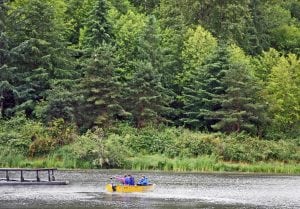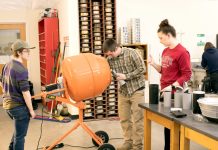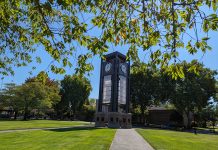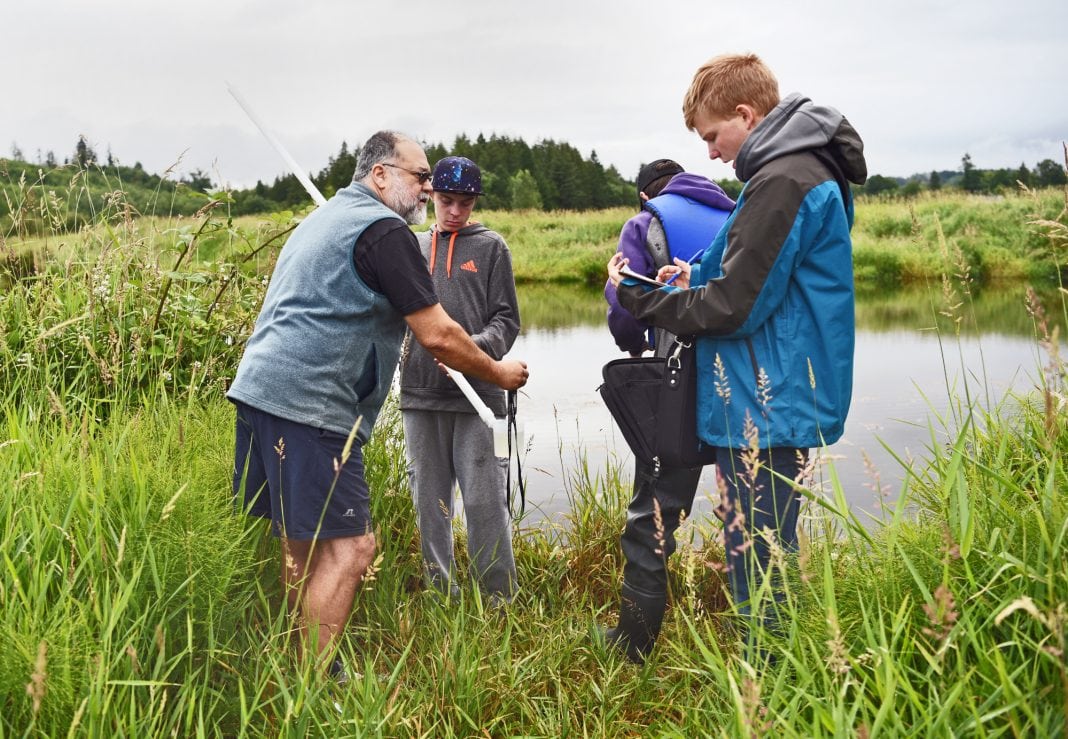Submitted by Paul Dunn for Chehalis Basin Partnership
Her friends on the boat call her “Captain Kasey.”
Once every month or two, Kasey Hoyt skippers a small outboard-motor-powered dingy around Carlisle Lake in Onalaska. The boat team takes water-quality readings of temperature, pH, conductivity, and dissolved oxygen. The boat team also takes a sample of the lake water to determine turbidity, phosphate content, and nitrate content.
Meanwhile, another 15 or so of her Onalaska High School science classmates perform similar tests on Carlisle Lake and nearby Gheer Creek — both a mere breaststroke from the entrance to the high school.

“I really enjoy driving the boat,” Hoyt said with a laugh recently. “My friends tease me and tell me I should get a hook hand.”
The 17-year-old STEM student and her science buddies are part of a water-quality team supervised by Onalaska High School science teacher Johnny Garcia. The group just finished its first significant year of monitoring and will continue monthly during the summer and into the future.
“These students are becoming more aware of the issues dealing with the water, and they enjoy hands-on activities,” Garcia explained during a mid-June monitoring session. “The monitoring helps us understand what life the creek and lake is capable of maintaining.”
Known by longtime Onalaska residents as the “Old Mill Pond,” 22-acre Carlisle Lake was originally a millpond for the Carlisle Lumber Company, which shut down in 1942. The lake and another 50 acres of surrounding land is currently owned by the Onalaska Alliance, a non-profit organization formed to restore the lake and surrounding area.
The Alliance and the Onalaska School District are developing Carlisle Lake recreational and environmental education resources for the public. The site now includes a recently paved parking lot to allow better access and bathrooms, funded by a grant from Lewis County. Future plans include cleaning the trail around the lake, providing wheelchair access and building a fishing dock.
Carlisle Lake is home to a diversity of native and non-native fish, including sunfish, catfish, brown and rainbow trout and large-mouthed bass. Native coho salmon are raised in pens on the lake, too.

That diversity of wildlife reflects the diversity of environmental stewardship the lake and creek have garnered over time — and especially in the past few years.
Onalaska High School students have been at the forefront of this effort. Though science teams have been evaluating the lake and creek for a few years, it wasn’t until the Onalaska Science Club Grant Writing Team secured a grant from TransAlta corporation — which owns the Centralia Coal Plant, the state’s largest baseload power source — that their lake monitoring shifted into high gear.
The $7,453 grant helped Garcia and his environmentally aware students purchase $10,000 of professional water-quality monitoring equipment. And it’s the students who use the equipment — not Garcia — though he’s there when glitches arise. In the past year, the salt-and-pepper-bearded science teacher has watched his charges move from amateur water sleuths to knowledgeable technicians.
“We couldn’t do any of this (monitoring) without the kids,” Garcia said. “Getting them to be a functional unit has been a slow process, but I’m seeing more professional behavior now. Our goal the past four months was for them to do all of the readings on their own with adults close by.”
And by all measures, it’s worked. Students, clustered in groups of three or four, gather water samples and rush them for evaluation to other students assigned to the lab. And if students have problems, an expert’s nearby to help.
On any given monitoring day, Garcia can expect help from two-to-four adult volunteers who help supervise students and augment Garcia’s knowledge about water-quality issues.
“We’re very fortunate to have them help us,” Garcia said. “They’re invaluable.”

Invaluable, too, is the enthusiasm many of Garcia’s students bring to their project. Sophomore Logan VanClifford exemplifies just such dedication. The 16-year-old STEM student relishes the knowledge he’s gaining from the program, but points to a higher purpose.
“I just like doing something good,” he said. “I can learn things through this project that I can’t learn in normal school, and I gain a sense of involvement with our community.”
Hoyt, who has been involved in the program for the past two years, echoed that sentiment.
“I enjoy meeting new people through our monitoring groups,” she said. “It also makes me feel good that I’m doing something for our community.”
For his part, Garcia has organized the monitoring group to include students of different ages. That allows younger students to gain experience and step in as older students graduate.
“The goal is for the students to become experts at the water quality tests when they’re called upon to perform them,” Garcia explained.

Students who participate in the program are typically active in such OHS offerings as Advanced Placement Environmental Science, STEM, and the Science Club, though other students may participate in the program, too.
Science Club students also work on the ecology around the lake, as demonstrated by their development of a published natural history book “A Natural Guide to the Plants of Carlisle Lake.”
“In the end, it’s just about understanding the environment around us,” Garcia concluded. “That’s our long-term goal.”
To learn how you can be involved in improving water quality in your local creek or river, visit the Chehalis Basin Partnership website.










































